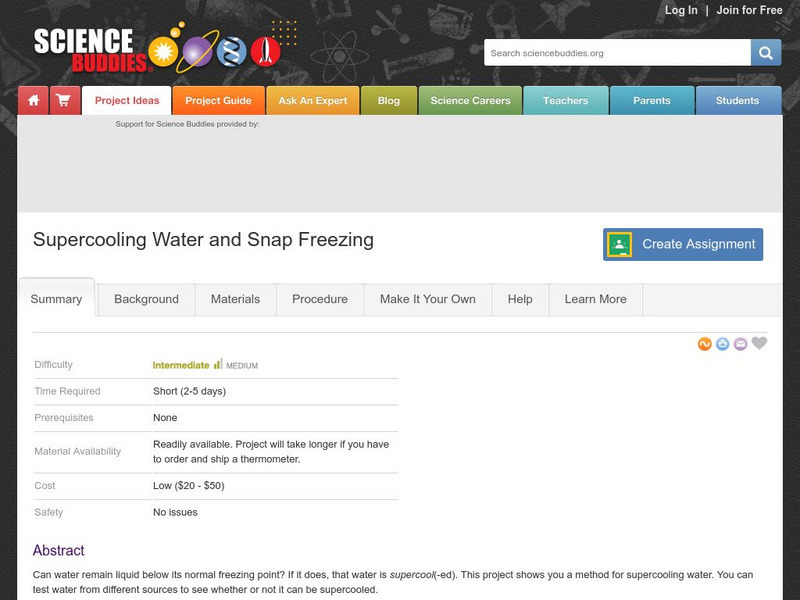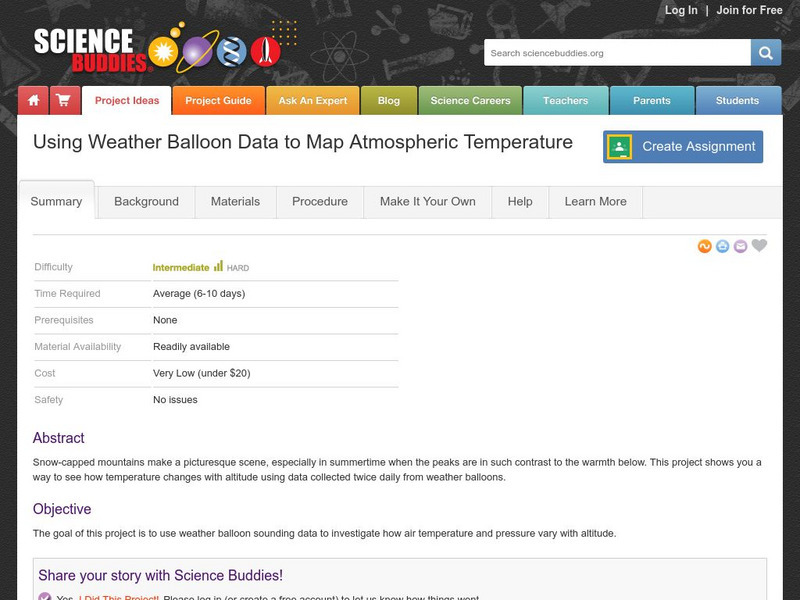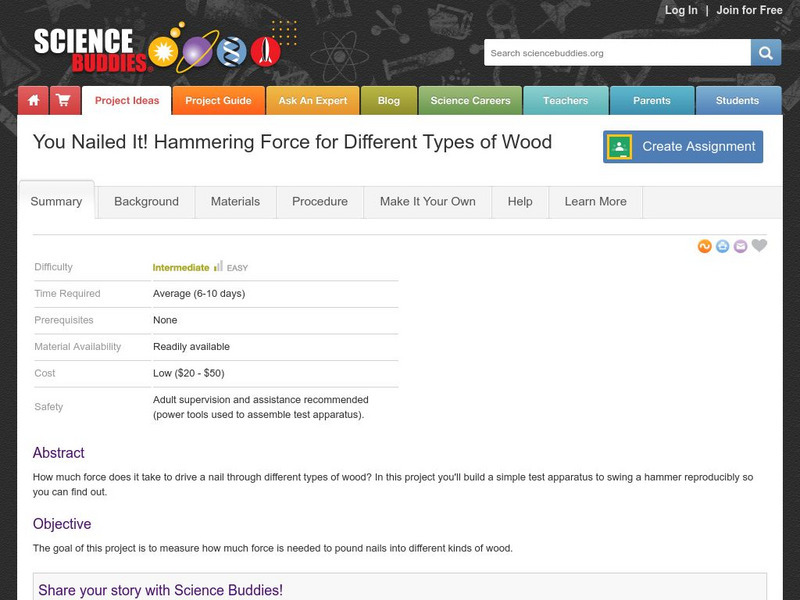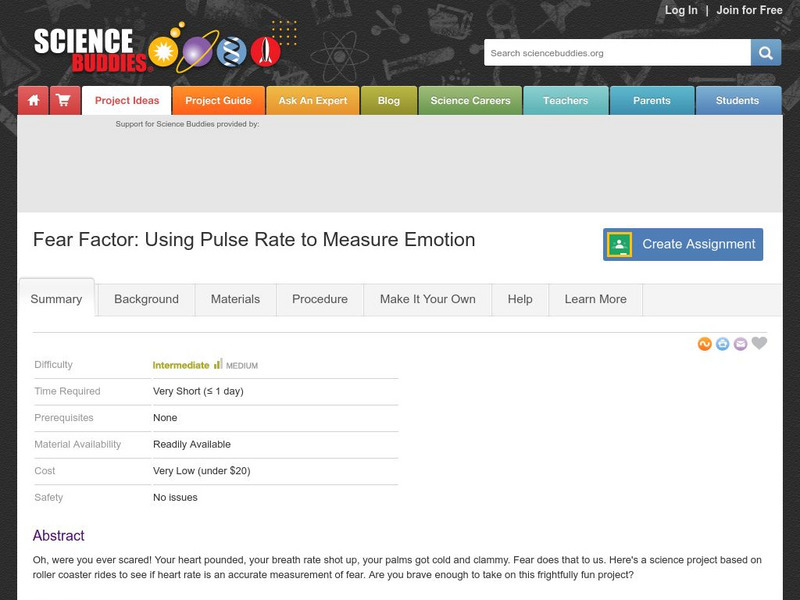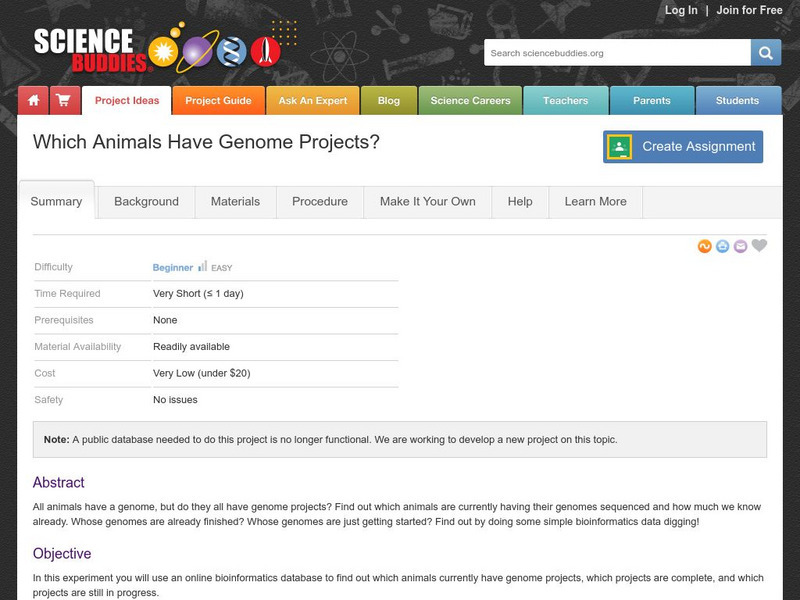Science Buddies
Science Buddies: A Magnetic Primer Designer
How do scientists "copy" DNA? They use a process called the Polymerase Chain Reaction, or PCR. The key to making this process work is having a primer that will stick to the piece of DNA you want to copy, called a template. In this...
Science Buddies
Science Buddies: How Atmospheric Temperature Affects the Water Content of Snow?
If you're lucky enough to live in a place that gets snow in winter, you know that the feel of the snow can vary a lot. Sometimes it can be light and fluffy, and other times heavy and wet. This project shows you how to use data from daily...
Science Buddies
Science Buddies: Investigate Mpemba Effect Can Hot Water Freeze Faster Than Cold
This physics project seems like it should have an easy answer. Instead, it turns out to be a great illustration of why it is important to base scientific conclusions on the outcome of controlled experiments. Things don't always turn out...
Science Buddies
Science Buddies: Supercooling Water and Snap Freezing
Can water remain liquid below its normal freezing point? If it does, that water is supercool(-ed). This project shows you a method for supercooling water. You can test water from different sources to see whether or not it can be...
Science Buddies
Science Buddies: Knock Your Blocks Off: The Mechanics of Carnival Games
Why are those "simple" games at the fairs, carnivals, and boardwalks so hard? Is it really lack of skill or coordination or do those concessionaires use some basic laws of science to help them set up the games in their favor? This...
Science Buddies
Science Buddies: Potions and Lotions: Lessons in Cosmetic Chemistry
Did you know that cosmetic companies employ teams of specialized chemists to develop and test each new line of make up, perfume, lotion, or soap? Here's a project that lets you be the cosmetic chemist. It shows you how to manufacture...
Science Buddies
Science Buddies: Using Weather Balloon Data to Map Atmospheric Temperature
Snow-capped mountains make a picturesque scene, especially in summertime when the peaks are in such contrast to the warmth below. This project shows you a way to see how temperature changes with altitude using data collected twice daily...
Science Buddies
Science Buddies: Ring of Fire 2: What Earthquakes Tell Us About Plate Tectonics
The theory of plate tectonics revolutionized geology in the 1960's. In this project you can explore the connection between plate tectonics and earthquakes by mapping historical seismic data.
Science Buddies
Science Buddies: Multitasking: Brain Drain or Boost in Efficiency?
Think it's a good idea to plug into iTunes, surf the Web, or watch TV while doing homework or trying to read? Many people do it and claim that jumping from one activity to another keeps their attention level up and even gives their brain...
Science Buddies
Science Buddies: Fallen Arches: The Surprising Strength of Eggshells
Arches have been used for structural engineering since ancient times. This experiment tests the strength of a naturally occurring arch shape: the shell of an egg. How much weight do you think an eggshell can support?
Science Buddies
Science Buddies: You Nailed It! Hammering Force for Different Types of Wood
This Science Buddies project explains how to build a mechanism that will reproducibly swing a hammer so you can determine the amount of force needed to hammer a nail through various densities of wood. The Science Buddies project ideas...
Science Buddies
Science Buddies: Are More Expensive Golf Balls Worth It?
There is a bewildering selection of different golf balls to choose from for playing the game. Some less expensive, some more expensive, all with different claims for the advantages they will bring to your game. This project can help you...
Science Buddies
Science Buddies: Asymmetric Dimple Patterns and Golf Ball Flight
Have you ever wondered why golf balls have a pattern of dimples on their surface? The dimples are important for determining how air flows around the ball when it is in flight. The dimple pattern, combined with the spin imparted to the...
Science Buddies
Science Buddies: Golf Clubs, Loft Angle, and Distance
If your idea of a great weekend morning is taking some practice swings at a driving range, or heading out to the links to play a round, this could be a good project for you. This project is designed to answer the question, what is the...
Science Buddies
Science Buddies: Tee Time: How Does Tee Height Affect Driving Distance?
If you're an avid golfer, this might be a fun project for you. When you're setting up to tee off out on the course, how much attention do you pay to putting the tee in the ground? The height of the tee can affect both where in the swing...
Science Buddies
Science Buddies: Mapping Troposhperic Ozone Levels Over Time
Ozone in the stratosphere protects the earth by absorbing harmful ultraviolet radiation from the sun. However, when ozone occurs in the troposphere, it is harmful to health. In this project you can use data from EPA monitoring stations...
Science Buddies
Science Buddies: Fear Factor: Using Pulse Rate to Measure Emotion
Do you remember a situation when you heart pounded, your breath rate shot up, and your palms got cold and clammy? Fear does that to us. Here's a science project based on roller coaster rides to see if heart rate is an accurate...
Science Buddies
Science Buddies: Extreme Sounds: Lessons in a Noisy World
Just how loud does a sound have to be for us to hear it? And how loud is too loud for our ears? Learn to measure levels of sound in this project, and discover the amazing auditory range your ears can detect in the noisy world around you.
Science Buddies
Science Buddies: Where Do Lizards Go for Lunch?
You've probably heard about differences between the left brain and the right brain in people. One hypothesis has it that brain lateralization evolved as a survival mechanism in animals with eyes on the sides of their heads. One eye could...
Science Buddies
Science Buddies: Tail Wagging and Brain Lateralization
The left brain is supposed to be better at language, and organizing sequential actions, the right brain is supposed to be better at visualizing orientations in space, making and listening to music, and deciphering the emotions of others....
Science Buddies
Science Buddies: What's the Point of Boiling?
You know that water can exist in three separate phases: solid (ice), liquid (water), and vapor (steam). To change from one phase to another, you simply add (or remove) heat. When water boils, what happens to molecules (for example sugar...
Science Buddies
Science Buddies: Which Animals Have Genome Projects?
All animals have a genome, but do they all have genome projects? Find out which animals are currently having their genomes sequenced and how much we know already by performing some simple bioinformatics data digging.
Science Buddies
Science Buddies: Technicolor Shadows: Lessons in Light and Color
Is that right side of your brain yearning to express its artistic side? This is a project that blends art with science. Learn about light and colorful shadows in these experiments where you mix and match various colors of light to create...
Science Buddies
Science Buddies: Balancing Act: Finding Your Center of Gravity
Like to have the balance of a tightrope walker? Try the more close - to - the - ground balancing test in this easy experiment to learn a few trade secrets of the high wire experts. In this project, you'll find your center of gravity and...





